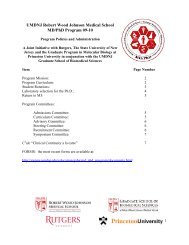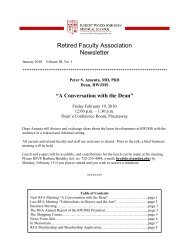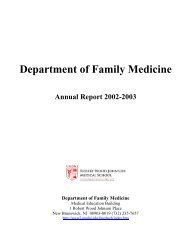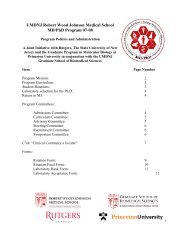Robert Wood Johnson Medicine • Spring 2011 • Population Science
Robert Wood Johnson Medicine • Spring 2011 • Population Science
Robert Wood Johnson Medicine • Spring 2011 • Population Science
Create successful ePaper yourself
Turn your PDF publications into a flip-book with our unique Google optimized e-Paper software.
University, Dr. Ma uncovered<br />
another gene, named junctophilin,<br />
as a biomarker for<br />
cardiovascular diseases.<br />
Junctophilin regulates how the<br />
different parts of the cell communicate<br />
with one another to coordinate<br />
the onset and termination<br />
of calcium inside the cells.<br />
Genetic mutations in junctophilin<br />
can cause heart failure, muscle<br />
wasting, or neurodegeneration.<br />
Dr. Ma’s research team is<br />
currently conducting laboratory<br />
research to understand how<br />
junctophilins function in normal<br />
physiology and how to apply the<br />
Cheryl F. Dreyfus, PhD<br />
In the demyelinating disease<br />
multiple sclerosis (MS), the<br />
myelin sheaths that surround<br />
nerves in the brain and spinal<br />
cord are inflamed and damaged.<br />
Cheryl F. Dreyfus, PhD, professor<br />
and acting chair, Department of<br />
Neuroscience and Cell Biology, is<br />
JOHN EMERSON<br />
Jianjie Ma, PhD<br />
team’s bench work to clinical<br />
medicine.<br />
Recently, a protein named MG53,<br />
a key initiator of cell membrane<br />
repair in damaged tissue, was<br />
discovered in Dr. Ma’s lab. This<br />
finding has generated wide interest<br />
in both academic research and<br />
the pharmaceutical industry.<br />
The protein is expected to have<br />
applications in repairing tissue in<br />
patients who suffer from severe<br />
complications of disease and<br />
aging, such as muscular dystrophy<br />
and heart failure.<br />
The translation of this research,<br />
through collaboration with clinicians<br />
and pharmaceutical companies,<br />
will help determine if what<br />
was discovered using animal<br />
prototypes can be applied to<br />
human treatment. To accelerate<br />
the development of these discoveries<br />
into clinical therapies, a<br />
university spin-off company,<br />
TRIM-edicine Inc., was created to<br />
commercialize the intellectual<br />
properties discovered in Dr. Ma’s<br />
laboratory at UMDNJ-<strong>Robert</strong> <strong>Wood</strong><br />
<strong>Johnson</strong> Medical School.<br />
The discoveries could have<br />
far-reaching applications in<br />
geriatric and regenerative<br />
medicine, to treat chronic human<br />
diseases as well as acute or<br />
traumatic tissue injuries. Funding<br />
for Dr. Ma’s research is provided<br />
by grants from the National<br />
Institutes of Health, with support<br />
from the New Jersey Commission<br />
on <strong>Science</strong> and Technology.<br />
Research Examines Potential for Treatment of Multiple Sclerosis<br />
leading a study to determine if<br />
there is a connection between<br />
the neurotrophin BDNF (brainderived<br />
neurotrophic factor) in<br />
the brain and reduction or even<br />
repair of the myelin damage.<br />
The study is currently supported<br />
by a four-year, $1,365,000<br />
grant from the National Institutes<br />
of Health and additional funding<br />
through a grant from the National<br />
Multiple Sclerosis Society.<br />
“In a culture dish, BDNF<br />
causes cells that are destined to<br />
become oligodendrocytes to<br />
divide and mature and to start<br />
to express the proteins associated<br />
with oligodendrocytes — the<br />
myelinating cells of the central<br />
nervous system,” explains Dr.<br />
ANDREW HANENBERG<br />
Dreyfus. “When we observed mice<br />
that have a reduced ability to<br />
make BDNF, we discovered that<br />
they exhibited a reduction in<br />
the number of oligodendrocyte<br />
progenitors and a reduced ability<br />
to express mature traits.”<br />
It was then that Dr. Dreyfus<br />
began to ask, “Could this have<br />
something to do with MS?”<br />
Dr. Dreyfus and her team<br />
evaluated effects of BDNF in<br />
a demyelinating mouse model<br />
of the disease. “In this model,<br />
a lesion in the myelin appears,<br />
which then repairs itself,” says<br />
Dr. Dreyfus. The mice that<br />
exhibited reduced BDNF did<br />
much worse in this model.<br />
Reduced BDNF affected a number<br />
of oligodendrocyte progenitors<br />
and their ability to repair the<br />
damage. Conversely, when BDNF<br />
was infused into the lesion site,<br />
it was able to partially reverse<br />
damage.<br />
Current work in the laboratory<br />
is investigating drugs that might<br />
be able to increase levels of<br />
BDNF in the brain. Dr. Dreyfus<br />
emphasizes that there is a long<br />
way to go before we understand<br />
how to manufacture such a drug<br />
that would increase BDNF and<br />
lead to repair. The hope is<br />
that one day we could have a<br />
significant effect on a devastating<br />
disease.<br />
<strong>Robert</strong> <strong>Wood</strong> <strong>Johnson</strong> ■ MEDICINE 11

















